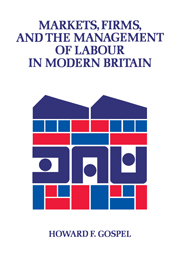Book contents
- Frontmatter
- Contents
- Preface
- 1 Introduction: the management of labour
- Part 1 The inheritance
- Part 2 Continuities and change in the first half of the twentieth century
- Part 3 Challenges and adjustments in the post-war years
- 6 Markets, firms, and the organisation of production
- 7 Industrial relations: challenges and responses
- 8 Employment relations in the post-war period
- Part 4 Conclusions
- Notes
- Index
6 - Markets, firms, and the organisation of production
Published online by Cambridge University Press: 23 November 2009
- Frontmatter
- Contents
- Preface
- 1 Introduction: the management of labour
- Part 1 The inheritance
- Part 2 Continuities and change in the first half of the twentieth century
- Part 3 Challenges and adjustments in the post-war years
- 6 Markets, firms, and the organisation of production
- 7 Industrial relations: challenges and responses
- 8 Employment relations in the post-war period
- Part 4 Conclusions
- Notes
- Index
Summary
This book has set the history of labour management in Britain in a broad economic and business context. It has argued that the legacy from the nineteenth century had a profound effect on the management of labour in the twentieth century. The first half of the twentieth century witnessed considerable changes in the structure of British industry which in part modified that traditional pattern of labour relations. Markets, which had at first been open and expanding, became subject in the interwar years to growing restrictive and protectionist tendencies. Newer industries based on mass-production technologies became firmly established. Corporate structures also changed and there was a growth of large firms and managerial hierarchies. However, there were also significant continuities from the nineteenth century. Britain remained heavily committed to the older staple industries and markets often remained highly fragmented and differentiated. With the exception of the two world wars, the labour market continued to be characterised by elastic labour supply. The large firms which emerged at the turn of the century and in the interwar years often remained loose federations of constituent companies with weak managerial hierarchies. In this environment, it was argued, many British employers retained traditional forms of work relations which were labour intensive, which afforded skilled workers considerable autonomy, and which constrained productivity growth. In terms of employment and industrial relations firms, for the most part, chose strategies of externalisation and failed to develop strong internal structures of labour management. Only a few exceptional firms, usually characterised by different market, structural, and managerial configurations, pursued different labour strategies and developed stronger internal structures of labour management.
- Type
- Chapter
- Information
- Markets, Firms and the Management of Labour in Modern Britain , pp. 105 - 126Publisher: Cambridge University PressPrint publication year: 1992



